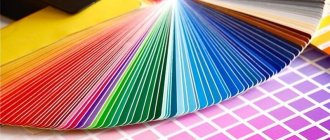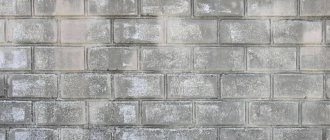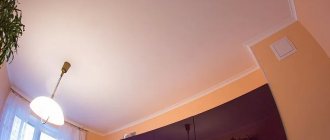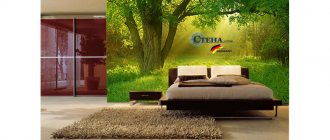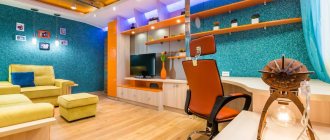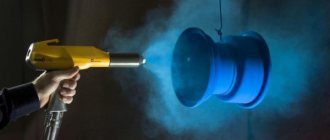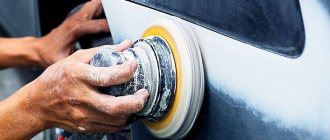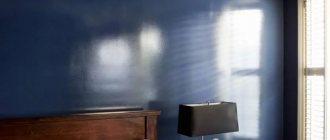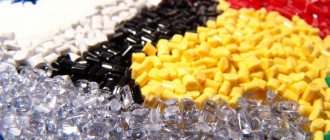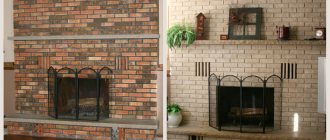Features: hanging the profile before painting.
Before applying paint to the profile, it is suspended. To attach the profile to the traverse, it is pre-drilled or holes with a diameter of 5 mm are punched on a stamp at a distance of 15 mm from the end of the profile. For simple aluminum profiles, holes must be made on the non-facial surface; for combined profiles, holes are drilled in the aluminum part.
The profiles are attached to the traverse using special hooks or aluminum wire. Depending on the type of paint line, there are specific features in the orientation of the profile on the suspension system. On painting lines with a horizontal suspension system, the combination profiles must be suspended from the aluminum, heavier part, to avoid distortion of the combination profile.
For horizontal system
suspension profiles must be secured to avoid excessive deflection.
The cause of deflection may be the heavy weight of the combined profiles, or their unequal cross-section. As a consequence after the painting process, there is a bent profile.
For vertical painting
When using equipment for vertical painting, it should be ensured that the combined profile is suspended from the heaviest bowl. If both bowls are heavy, then fasten them to each bowl of a combined profile.
Strictly avoid hanging the combined profile by the thermal insert.
Two types of powder paints
The main types of powder paints are:
- thermoplastic and
- thermosetting.
Thermoplastic powder paints
When exposed to heat, thermoplastic powder paints melt and spread over the surface in the form of a film. This film has the same chemical composition as the original powder. Thermoplastic powder coatings are based on high molecular weight thermoplastic resins. These resins are difficult to grind into fine particles and are therefore usually used to create special thick coatings. The application of powder to the product usually occurs while it is immersed in a tank of liquefied powder. The powder is liquefied using compressed air.
This type of powder includes polyethylene, polypropylene, nylon, polyvinyl chloride and some others.
Thermoplastic powder paints are not suitable for painting bulk aluminum products such as extruded aluminum profiles or rolled aluminum sheets.
Thermosetting powder paints
Thermosetting powder paints differ significantly from thermoplastic ones. They are based on low molecular weight solid resins. Under the influence of heat, thermosetting powders melt, spread over the surface and combine with each other as a result of chemical reactions to form high-molecular organic compounds. This process is called polymerization. Therefore, the finished powder coating has a chemical composition that is different from the chemical composition of the original resins in the powder paint.
The finished coating material made from thermosetting powder paints is resistant to heat and does not melt to a liquid state. Thermoset powder paints are based on harder resin systems that can be ground into fine particles ranging from 10 to 40 microns or even finer. These resins can form thin paint layers ranging from 25 to 75 microns in thickness, with performance equivalent to or better than liquid paint based coatings.
When powder painting aluminum products, primarily profiles and sheets, thermosetting powder paints are used. The main types of thermosetting powder paints that are used for painting aluminum products and semi-finished products are:
- epoxy,
- polyester,
- polyurethane,
- acrylic,
- hybrid (mixed).
The choice of powder paint type depends on the type of aluminum product, its purpose, its operating conditions and other factors. The standard and most popular powder coatings are polyester paints.
Applying powder paint to the surface to be painted.
After hanging, the profiles are placed in a spray chamber, where powder paint is applied to them manually or automatically.
The main purpose of the spray chamber is to capture powder particles that have not settled on the product, recycle paint and prevent it from entering the room. The spray booth is equipped with a filter system and built-in cleaning means (for example, hoppers, vibrating screens, etc.), as well as suction systems.
The chambers are divided into portion and walk-through chambers. Typically, small-sized products are painted in portion chambers, and long-length ones are painted in walk-through chambers.
The most common method of applying powder coatings is electrostatic spraying. It involves applying charged particles of powder paint to a grounded product using a pneumatic spray gun.
The coating thickness at the outlet is 50-60 microns.
The sprayer combines a number of different operating modes:
- tension can spread both upward and downward;
- the powder output speed (paint flow force) can be adjusted;
- The distance from the nozzle outlet to the part may vary.
There are two types of electrostatic spray:
- electrostatic spraying with particle charging in a coronal charge field, i.e. paint particles receive a charge from an external source of electricity - a corona electrode;
- tribostatic spraying, when paint particles receive a charge as a result of their friction against the walls of the spray turbine.
The disadvantage of the first method is that when using it, difficulties may arise in applying paint to surfaces with blind holes and recesses. Since paint particles are first deposited on the raised areas of the surface, it may be painted unevenly. With tribostatic spraying, no power source is required, so this method is much cheaper. It is used for painting parts with complex shapes. The disadvantages of the tribostatic method include the low degree of electrification, which significantly reduces its productivity: 1.5-2 times compared to a discharge electrode.
Stages of powder painting of aluminum
After cleaning, paint is applied to the prepared surface. As a working tool for this operation, special electric or pneumatic guns are used, which make it possible to evenly apply powder to the entire aluminum workpiece. Theoretically, this can be done manually, but in this case many problems can arise. The main disadvantage is that using manual technology it will not be possible to evenly distribute the powder over the entire surface, as a result of which the quality of the color will be poor.
At the final stage of aluminum powder painting, the powder is polymerized so that it can firmly adhere to the metal surface. This operation can be performed in several ways:
- By heating the metal. The metal blank is heated in a furnace to a temperature exceeding the melting level of the paint. The powder is placed in a small chamber connected to a compressor unit. The heated part is installed in a chamber with paint, in which a high, stable temperature is maintained using a compressor. Physically, the process is very simple: when paint hits a hot surface, it sticks to the metal and instantly melts, thereby creating a polymer colored layer. This technology is applicable only for painting small-sized products.
- Using gas burners. The fire of several gas burners is simultaneously directed onto the painted part, as a result of which the temperature can rise and be maintained at a level of about +1,500...+2,000 °C. Polymer solidification occurs due to partial melting and subsequent cooling. This technique has some disadvantages: it is used for powder painting of fairly large aluminum parts in cases where they do not fit into airless ovens.
- Through temperature polymerization. The painted metal workpiece is placed in an airless chamber preheated to +180…+210 °C. At this temperature, polymer particles fuse, which leads to the appearance of a uniform, durable layer of paint. This method is considered the most universal and can be used for painting any surfaces with medium-sized workpieces.
An important point is the correct choice of equipment, taking into account the dimensions of the products that you plan to paint. Painting of long aluminum profiles should be done on automatic lines equipped with polymerization ovens and pass-through chambers for spraying. It is advisable to use dead-end equipment when applying coatings to products such as disks or other small parts.
You should always pay attention to the quality of coloring materials. Any batch of powder paints for aluminum profiles and other similar products must be accompanied by a certificate of conformity when sold. Otherwise, no one can guarantee that aluminum powder coating will be of high quality and durable.
Oven polymerization.
After applying powder paint, the product goes through the coating formation stage. It involves melting a layer of paint, subsequent production of a coating film, its curing and cooling. The reflow process takes place in a special reflow and polymerization oven.
Melting and polymerization occurs at a temperature of 150-220 ° C for 15-25 minutes, after which the powder paint forms a film (polymerizes). The main requirement for polymerization chambers is to maintain a constant set temperature (temperature variation of at least 5°C is allowed in different parts of the furnace) for uniform heating of the product.
When a product coated with a layer of powder paint is heated in an oven, the paint particles melt, become viscous and merge into a continuous film, displacing the air that was in the layer of powder paint. Some air may still remain in the film, forming pores that degrade the quality of the coating. With further heating of the profile, the paint penetrates deeply into the surface and then hardens. At this stage, a coating is formed with the specified characteristics of structure, appearance, strength, protective properties, etc.
When painting large metal parts, their surface temperature rises much more slowly than that of thin-walled products, so the coating does not have time to fully harden, resulting in reduced strength and adhesion. In this case, the part is preheated or the curing time of the coating is increased. It must be remembered that when applying powder coating to thermal inserts, temperature also plays a decisive role. In this case, the temperature of the structure to be painted should not exceed 180 °C - 200 °C, and the residence time in the oven should not exceed approximately 20 minutes.
Exceeding the temperature and time will lead to deformation of the profile, as well as to the fact that the thermal insert will lose its strength and, therefore, will not be able to ensure the stability of the geometry of the combined profile.
Polymerization furnaces are divided into pass-through and batch, horizontal and vertical, single- and multi-pass. For batch ovens, an important point is the rate of temperature rise. This requirement is best met by ovens with air recirculation.
Preparing the aluminum surface for powder painting
To guarantee a high-quality powder coating on an aluminum part, its surface must first be prepared using a complex chemical treatment technology. Such surface preparation before powder painting of aluminum is necessary in order to:
- remove any contaminants from surfaces, including oxides, oils and greases;
- prepare the surface for better adhesion of the powder coating;
- obtain the most uniform coating over the entire surface of the part to be painted.
To carry out the standard procedure for chemical preparation of an aluminum surface, it is necessary to perform the following steps:
- degrease the workpiece using special cleaning solutions;
- rinse thoroughly in clean water to remove any chemical particles remaining on the surface;
- carry out etching in a caustic soda solution for a certain time and at a special temperature;
- treat the surfaces with a solution of sulfuric or nitric acid (clarify);
- create a chromate conversion layer (or technically equivalent) through processing to ensure good adhesion of the powder coating;
- Finally rinse in a container filled with deionized water.
It is necessary to especially highlight the fact that only if all requirements for preparing the surface for powder painting of aluminum are fully met, it is possible to use the maximum potential of such paint and obtain a reliable and durable protective and decorative coating.
For small volumes of aluminum powder painting production, the horizontal method of chemical processing of profiles is most often used, sequentially immersing the product in installed washing and working baths. In mass production, profiles are processed using the method of vertical systems, into which process solutions and washing water are supplied using a sprayer unit.
